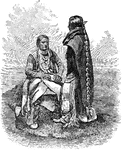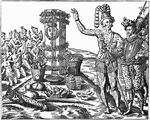
John Eliot Preaching to the Indians
John Eliot (c. 1604 - 21 May 1690) was a Puritan missionary born in Widford, Hertfordshire, England.…

Miami River
An illustration of the mouth of the Miami River. The Miami River is a river in Florida that drains out…

A Jesuit Missionary Preaching to the Indians
A drawing of a Jesuit missionary preaching to Native Americans.

Chattanooga, Tennessee in 1862
Chattanooga, "the Scenic City", is the fourth-largest city in Tennessee (after Memphis, Nashville, and…

Oshawahnah
Tecumseh's deputy commander who led the Indians against American forces at the Battle of the Thames

Ute Indians
The Utes are an ethnically related group of American Indians now living primarily in Utah and Colorado.…

Attack on the Narraganset Indians at South Kingston
Attack on the Narraganset Indians at South Kingston by the leaders of the Massachusetts Bay Colony.

Chief Joseph
Chief Joseph (March 3, 1840 – September 21, 1904) was the chief of the Wal-lam-wat-kain (Wallowa)…

Teepee
A tipi (also teepee, tepee) is a conical tent originally made of animal skins or birch bark and popularized…

Death of Major Richard Waldron
On September 7, 1676, Waldron invited about 400 Indians to participate in a mock battle against the…

Scull
A man using a single scull to row a boat. Sculling was used by ancient Chinese, American Indians, and…

The Rescue of Israel Putnam from the Indians
"The French officer rescuing Putnam from the Indians." - Lossing

Seal of Kansas
The Great Seal of the State of Kansas, 1861. The seal pictures a sunrise, a steamboat, plowing, a wagon,…

Rabbit Stick
"A throwing-stick, similar to the Australian boomerang, used by the Indians of the southwestern United…

Osceola, Chief of the Seminoles
Chief Osceola of the Florida Seminole Indians stands proudly at his tribe's village.

Osceola, Chief of the Seminoles
(1804-1838) Osceola was a war chief of the Seminole Indians in Florida, most recognized for his leadership…

William Penn
William Penn (October 14, 1644 – July 30, 1718) was founder and "Absolute Proprietor" of the Province…

Man Preaching to Native Americans
An illustration of a man preaching to a group of Native Americans with teepees.

Native American Rebus
"Eighty armed Pottawattomie Indians surround a house and attack the inmates." -Trowbridge, 1866

Criticism of Native American's Exclusion from Franchise
Nast depicts the criticism of Native American's exclusion from franchise by the caption "move on!".…

Stand Against Indian Outbreaks
Army of the Frontier stands firm against Indian outbreaks, despite retrenchment, red-tape, and a political…

The Return of the Warriors
In the short story of The Arickara Indians, the image depicts the return of the Indian warriors on horses.
Indian Crosse Stick
This illustration shows an Indian crosse stick, as described by Gatlin. About fifty tribes of Indians…

Colonists Interacting with Native Americans
A scene of New England colonists talking with several Native Americans in a wooded glen. In the background…










